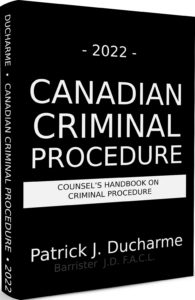 |
| Patrick Ducharme |
The air of reliability test sounds very much like another test that has been used for years to determine whether there is an evidential foundation warranting that a defence be put to a jury. According to the Supreme Court of Canada in R. v. Cinous1 the air of reality test is as follows:
We conclude that the authorities after Pappajohn v The Queen continue to support a two-pronged question for determining whether there is an evidential foundation warranting that a defence be put to a jury. The question remains whether there is (1) evidence (2) upon which a properly instructed jury acting reasonably could acquit if it believed the evidence to be true. The second part of this question can be rendered by asking whether the evidence put forth is reasonably capable of supporting the inferences required to acquit the accused. This is the current state of the law, uniformly applicable to all defences.
Consequently, the air of reality test is a principle of law that a defence should only be presented to a jury for consideration if there is an evidential foundation for it. And, this test has long been recognized by the common law.3 However, the obvious difference between the air of reliability test referred to by Paciocco J. and other Justices in the East Region and the air of reality test is that the air of reality test is applied after all the evidence is heard providing the trial Judge with a strong measure of evidentiary context by which the decision can be made. The air of reliability test, in contrast, is to be made by Justices examining a statement or a document without context, without any ability to actually test the reliability of it.
In R. v. Buzizi4 the Supreme Court of Canada was required to determine whether the defence of provocation should have been put to the jury. Were the objective and subjective elements of the defence of provocation established thereby lending an air of reality to this defence? Fish J. raised the concept of an air of reality test to a question of law, rather than a question of fact. In doing so, he challenged the reasoning of minority Justice Wagner as follows:
With respect, I have three brief observations concerning the reasons of Justice Wagner.
First, my colleague finds that an appellate court must defer to the trial Judge in determining whether a defence has an air of reality. As my colleague acknowledges, however, the applicable standard of review in this regard is correctness. It follows, in my view, that the trial Judge is not at all in the “best position” to determine whether a defence has an air of reality, since that is a question of law:…the interpretation of a legal standard (the elements of the defence) and the determination of whether there is an air of reality to a defence constitutes questions of law, reviewable on a standard of correctness.
What remains clear is that the air of reality test used to determine whether a defence should be left to a jury has very specific parameters and is required to be based on a consideration of all the evidence presented at trial, together with legal principles, prior to addresses of counsel to the jury. This test is applied in far different circumstance than examining documents presented by a Crown to a Judge prior to admission at a preliminary inquiry, without context, and without guiding legal principles. Most often the circumstances will not permit any actual or reasonable testing of the reliability under subsection 540 (7).

The above is the an excerpt of Patrick J Ducharme's book, Canadian Criminal Procedure, available at Amazon or in bulk through MedicaLegal Publishing along with Criminal Trial Strategies.
Subscribe to Patrick Ducharme's Youtube Channel
